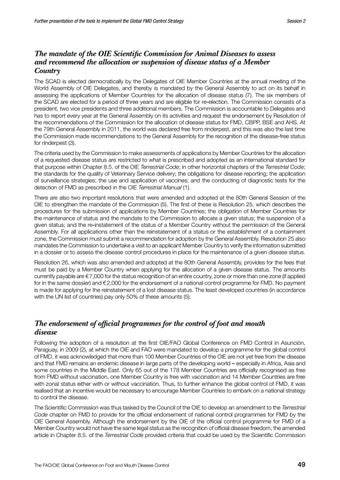Further presentation of the tools to implement the Global FMD Control Strategy
Session 2
The mandate of the OIE Scientific Commission for Animal Diseases to assess and recommend the allocation or suspension of disease status of a Member Country The SCAD is elected democratically by the Delegates of OIE Member Countries at the annual meeting of the World Assembly of OIE Delegates, and thereby is mandated by the General Assembly to act on its behalf in assessing the applications of Member Countries for the allocation of disease status (7). The six members of the SCAD are elected for a period of three years and are eligible for re-election. The Commission consists of a president, two vice presidents and three additional members. The Commission is accountable to Delegates and has to report every year at the General Assembly on its activities and request the endorsement by Resolution of the recommendations of the Commission for the allocation of disease status for FMD, CBPP, BSE and AHS. At the 79th General Assembly in 2011, the world was declared free from rinderpest, and this was also the last time the Commission made recommendations to the General Assembly for the recognition of the disease-free status for rinderpest (3). The criteria used by the Commission to make assessments of applications by Member Countries for the allocation of a requested disease status are restricted to what is prescribed and adopted as an international standard for that purpose within Chapter 8.5. of the OIE Terrestrial Code; in other horizontal chapters of the Terrestrial Code; the standards for the quality of Veterinary Service delivery; the obligations for disease reporting; the application of surveillance strategies; the use and application of vaccines; and the conducting of diagnostic tests for the detection of FMD as prescribed in the OIE Terrestrial Manual (1). There are also two important resolutions that were amended and adopted at the 80th General Session of the OIE to strengthen the mandate of the Commission (5). The first of these is Resolution 25, which describes the procedures for the submission of applications by Member Countries; the obligation of Member Countries for the maintenance of status and the mandate to the Commission to allocate a given status; the suspension of a given status; and the re-instatement of the status of a Member Country without the permission of the General Assembly. For all applications other than the reinstatement of a status or the establishment of a containment zone, the Commission must submit a recommendation for adoption by the General Assembly. Resolution 25 also mandates the Commission to undertake a visit to an applicant Member Country to verify the information submitted in a dossier or to assess the disease control procedures in place for the maintenance of a given disease status. Resolution 26, which was also amended and adopted at the 80th General Assembly, provides for the fees that must be paid by a Member Country when applying for the allocation of a given disease status. The amounts currently payable are € 7,000 for the status recognition of an entire country, zone or more than one zone (if applied for in the same dossier) and € 2,000 for the endorsement of a national control programme for FMD. No payment is made for applying for the reinstatement of a lost disease status. The least developed countries (in accordance with the UN list of countries) pay only 50% of these amounts (5).
The endorsement of official programmes for the control of foot and mouth disease Following the adoption of a resolution at the first OIE/FAO Global Conference on FMD Control in Asunción, Paraguay, in 2009 (2), at which the OIE and FAO were mandated to develop a programme for the global control of FMD, it was acknowledged that more than 100 Member Countries of the OIE are not yet free from the disease and that FMD remains an endemic disease in large parts of the developing world – especially in Africa, Asia and some countries in the Middle East. Only 65 out of the 178 Member Countries are officially recognised as free from FMD without vaccination, one Member Country is free with vaccination and 14 Member Countries are free with zonal status either with or without vaccination. Thus, to further enhance the global control of FMD, it was realised that an incentive would be necessary to encourage Member Countries to embark on a national strategy to control the disease. The Scientific Commission was thus tasked by the Council of the OIE to develop an amendment to the Terrestrial Code chapter on FMD to provide for the official endorsement of national control programmes for FMD by the OIE General Assembly. Although the endorsement by the OIE of the official control programme for FMD of a Member Country would not have the same legal status as the recognition of official disease freedom, the amended article in Chapter 8.5. of the Terrestrial Code provided criteria that could be used by the Scientific Commission
The FAO/OIE Global Conference on Foot and Mouth Disease Control
49
















